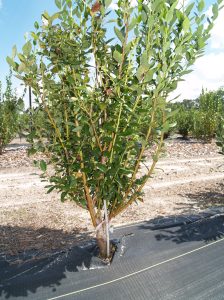Sustainability and profitability of the Florida blueberry industry are constrained by high production costs, including extensive soil amendments and the need to hand harvest fresh-market berries. Sparkleberry, a wild blueberry species, grows well on nonamended soils and has a tree-like growth habit, making it more amenable to mechanical harvesting. Incorporating these traits into highbush blueberry would alleviate soil constraints and facilitate mechanical harvesting. Our approach is to use southern highbush blueberry (SHB) cultivars grafted onto sparkleberry rootstocks. We believe grafted plants will be better suited to mechanical harvest and less dependent on soil amendments than own-rooted plants. Plantings of grafted vs own-rooted SHB were established in 2011 at two locations. Preliminary data indicate that by the second year after planting, vegetative growth of grafted plants increased more than vegetative growth of own-rooted SHB, particularly on non-amended soil. Further, our early data show that fruit ground loss during mechanical harvesting may be reduced 40% in grafted vs own-rooted plants. We propose to evaluate vegetative/reproductive growth, yield, and mechanical harvesting efficiency over the next two years in grafted vs own-rooted SHB grown on amended vs non-amended soil. We anticipate that grafted SHB will exhibit greater growth, yield, and improved mechanical harvesting traits compared with own-rooted plants.
See this article in Growing Produce magazine. You can also view the following videos:
Sparkleberry as a Potential Rootstock for Southern HIghbush Blueberry
Traits Needed to Develop Blueberry Varieties for Mechanical Harvest

